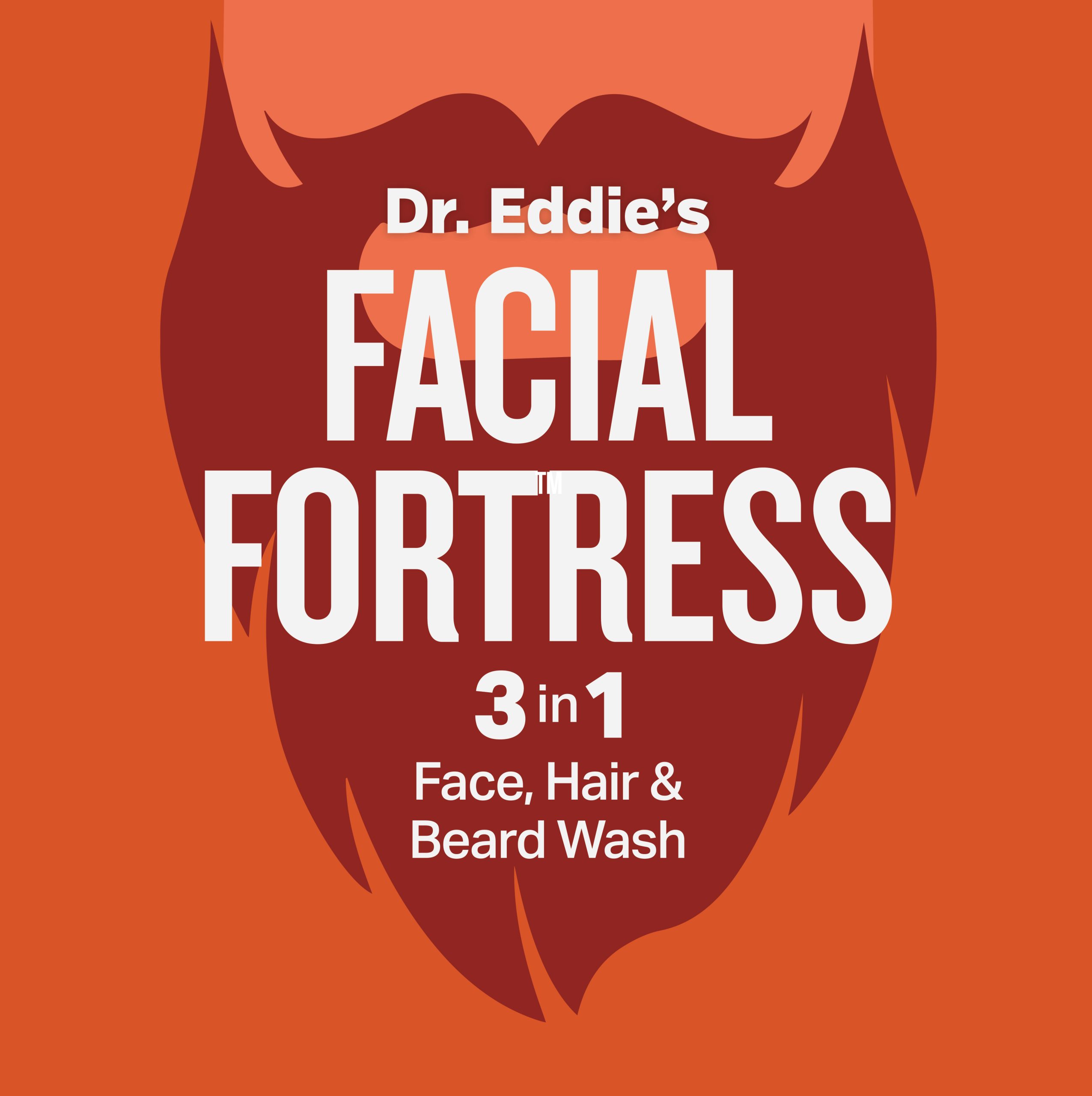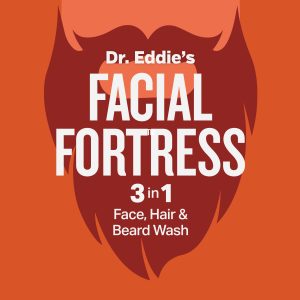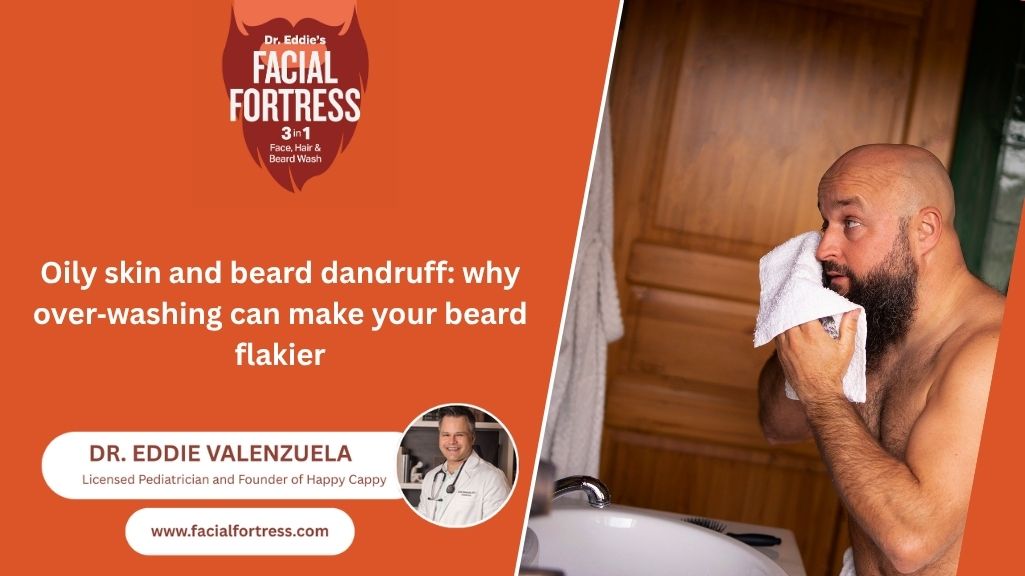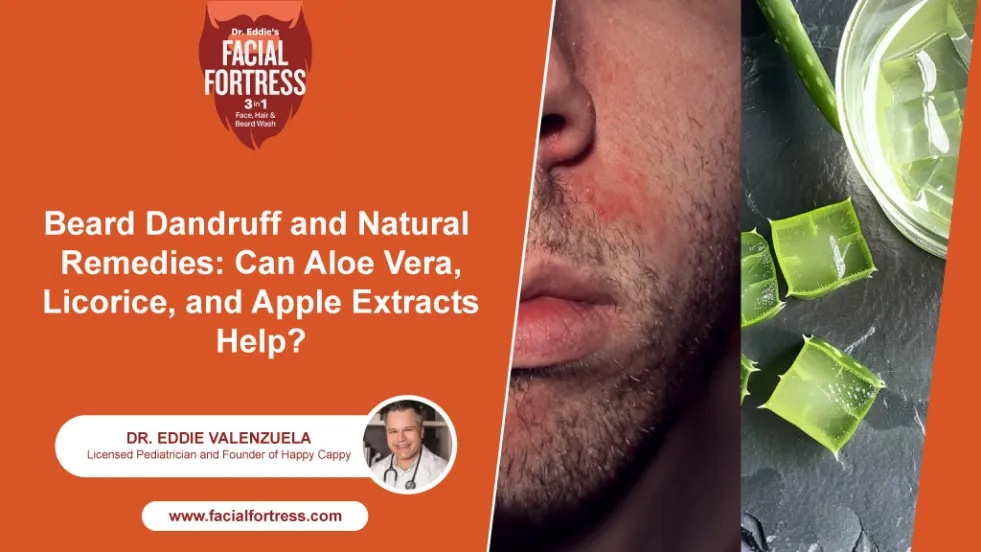Mustache Dandruff: Symptoms, Causes, and Treatment
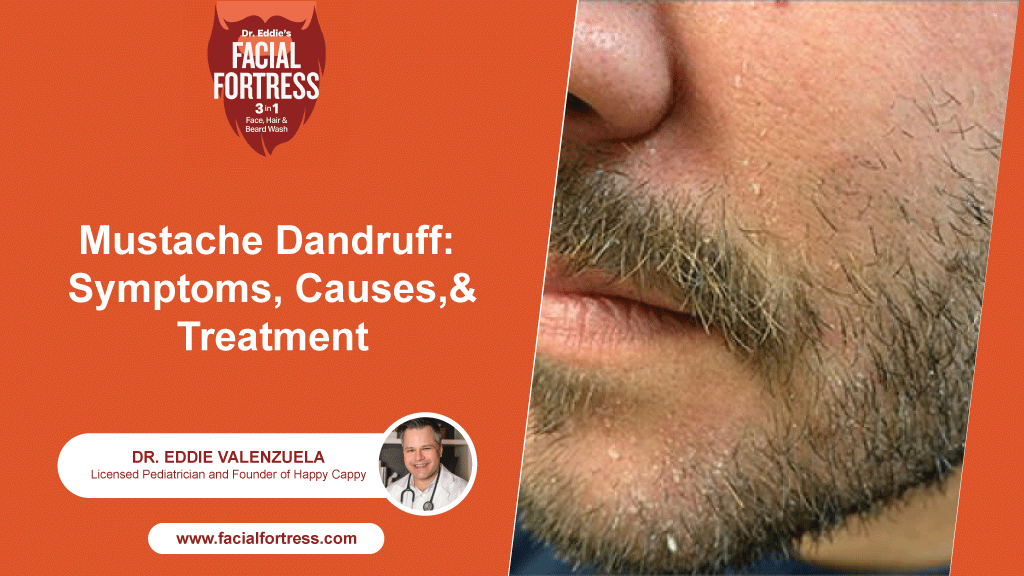
Dandruff is one of the most common and frustrating skin conditions we know and dislike. But when those pesky, tiny, white dandruff flakes start hanging around on your mustache and beard, it can be even more annoying.
Not only can they spoil your appearance, but they can also cause itching and irritation on the skin, and usually at the worst possible times. But don’t worry, you are not alone; Dr. Eddie, who has spent more than a decade treating patients dealing with dandruff, seborrheic dermatitis, and cradle cap, is here to help you.
Read this blog to discover what causes mustache dandruff and how to get rid of it so you can enjoy a clean, healthy, flake-free beard and mustache.
One more thing before we get started. Whether you spell it ‘moustache’ like the Brits or ‘mustache’ like Americans, it’s the same patch of hair—and just as prone to flaking.
What is Mustache Dandruff?
Just like dandruff on the scalp, when those white or yellow dandruff flakes start appearing on your mustache, it is known as mustache dandruff, and when it affects your beard, we call it beard dandruff.
Whether it’s in the beard or the mustache, the flaking issue is essentially the same as dandruff, but people often use different names depending on where it appears. And when you are experiencing a more severe form of dandruff, it is usually diagnosed as seborrheic dermatitis.
Want to know what causes dandruff in the mustache? Read on.
What Does Dandruff on a Mustache Look Like?
If you have never experienced dandruff on your mustache or beard, you may be curious about what it looks like. It looks pretty much the same as the dandruff you get on the scalp and causes similar dandruff symptoms, such as
- Yellow or white flakes on the mustache and beard
- Mild redness under the mustache
- Skin irritation
- Itchy skin
- Excessively greasy or oily skin
- Inflammation (especially if it’s seborrheic dermatitis)
However, there are other skin conditions, such as eczema, psoriasis, and rosacea, that can cause similar symptoms, so if you are unsure whether those flakes are caused by dandruff or something else, then it is best to consult a dermatologist.
What Causes Dandruff in the Beard and Mustache?
Most of us think that dandruff is caused by dry skin. Well, dry skin can cause the appearance of tiny white flakes and dry, flaky skin under the mustache. But in reality, it is not dandruff; it’s just dry skin.
The primary cause of dandruff, according to the researchers, is the overproduction of Malassezia yeast on the skin and scalp. However, there are certain other factors, such as the presence of excess sebum and skin sensitivity towards oleic acid, that work along with this yeast to give you those dandruff flakes.
Here is how they work together to give you the itching, flaking, and irritation associated with dandruff.
Excess Sebum
Our skin produces an oily substance known as sebum, which is essential for keeping it moisturized. However, sometimes the skin starts producing excess sebum due to certain factors, such as genetics, hormonal imbalances, certain skin conditions, or environmental triggers.
Overgrowth of Malassezia Yeast
The sebum our skin produces is the food that helps Malassezia yeast thrive. Don’t worry, this yeast is usually not harmful and actually essential for a healthy skin microbiome. However, when there is an excess of sebum on the skin, Malassezia yeast starts growing at a much faster rate, which can lead to skin conditions such as dandruff, seborrheic dermatitis, and Malassezia folliculitis.
Reaction to Oleic Acid
When the yeast feeds on sebum, it produces a byproduct known as oleic acid. Some people have sensitivity towards this acid, which can trigger itching and irritation on the skin.
Additionally, it causes the skin cells to start shedding at a much faster rate, so quickly that it does not give the dead skin cells enough time to fall. So these dead cells, due to the presence of sebum, start to clump together and take the form of dandruff flakes.
How to Get Rid of Mustache Dandruff?

When you have mustache dandruff, the first thing you would want is to get rid of it. Here is how to remove dandruff from the beard and mustache.
Use an Anti-Dandruff Shampoo
The best and easiest way to get rid of mustache dandruff is to use an anti-dandruff shampoo. But can you use any dandruff shampoo? The answer is no. The hair on your scalp and facial hair is a little different from each other.
Using regular dandruff shampoo can actually irritate your skin and worsen the condition because it often contains harsh chemicals, such as fragrances, parabens, and sulfates. So what should you use then? A medicated anti-dandruff beard wash like Facial Fortress 3-in-1 face, beard, and hair wash.
It is specially formulated by Dr. Eddie and infused with 0.95% pyrithione zinc as an active ingredient to help reduce the flaking, scaling, itching, and irritation associated with dandruff and seborrheic dermatitis on the scalp, beard, and mustache.
Use it 2 to 3 times a week to cleanse your beard and mustache and reduce the appearance of dandruff. If you have seborrheic dermatitis, then the doctor may advise you to use it daily until your condition starts getting better.
Don’t Scratch
We know that the itching caused by dandruff can be very difficult to resist at times. However, you must understand that scratching your mustache can worsen your condition. When you scratch your mustache, you may damage the hair follicles or the skin beneath it, which can lead to other complications such as hair loss, skin irritation, and skin infections.
Don’t Pick at Flakes
Those little white flakes hanging around your mustache can be very embarrassing at times, and you may start picking at them to get rid of them fast. But that’s not a solution; in fact, picking at flakes can actually make your condition worse, especially when you transfer bacteria from your hands to the skin.
So, try not to pick at flakes; instead, use a medicated anti-dandruff beard shampoo to wash away your flakes.
Home Remedies for Dandruff
When you search the internet for dandruff treatment, you will come across various home remedies, such as using olive oil, apple cider vinegar, and coconut oil for dandruff. These remedies may help soften the flakes and moisturize the skin, but they cannot help treat the root cause of dandruff.
In fact, leaving or applying any type of oil to the skin can further trigger the growth of malassezia on the skin and exacerbate your dandruff. Here is what Dr. Eddie has to say about using natural remedies for dandruff. “Natural oils like coconut or olive oil might seem like a gentle solution, but they can actually feed the yeast on your skin that causes dandruff and irritation. Instead of helping, these oils can make the redness, itching, and flaking even worse.”
Anti-Dandruff Shampoo for Facial Hair Dandruff
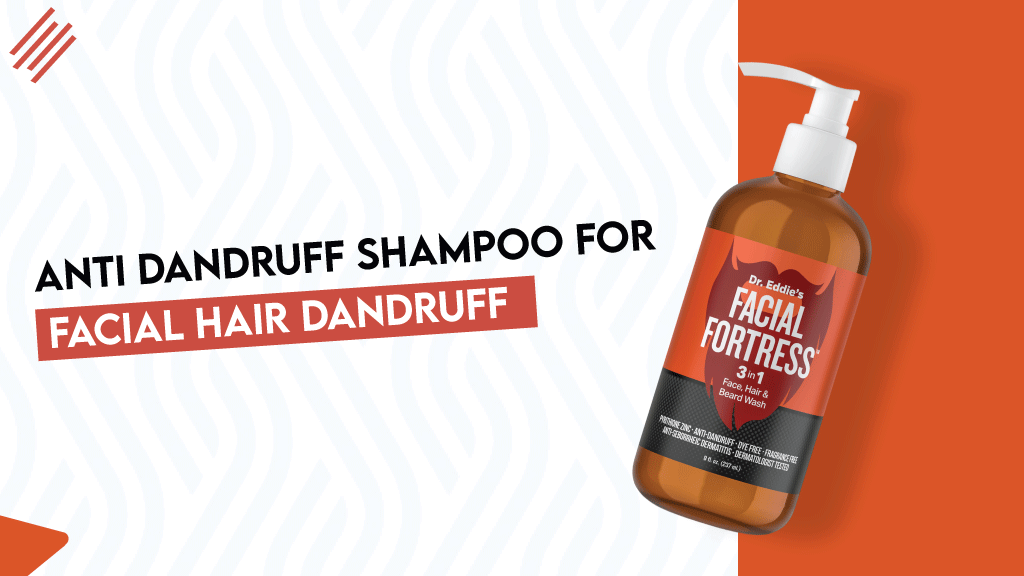
As we discussed earlier, most dandruff shampoos are not suitable for use on your mustache and beard, as the skin under them is much more sensitive than the skin on the scalp.
This is why using a beard shampoo for dandruff, like Dr. Eddie’s Facial Fortress 3-in-1 Medicated Wash, is a great solution. What makes it stand out? It is
- Fragrance-free
- Paraben-free
- Sulfate-free
- Dye-free
- Hypoallergenic
- Suitable for sensitive skin
- Doctor-approved
- Suitable to be used on the face, beard, and scalp.
And most importantly, it contains an FDA-approved active ingredient, pyrithione zinc, which has been proven effective in various studies in reducing the flaking and scaling associated with dandruff and seborrheic dermatitis.
It is also packed with natural ingredients, including apple fruit extract, licorice extract, glycerin, and provitamin B5, that help moisturize and keep your beard, mustache, and hair soft and nourished.
Conclusion
mustache dandruff may sound like a myth, but it’s a reality. People who have experienced it know how annoying and embarrassing it can be. Dandruff, whether it’s in your beard, mustache, or scalp, is believed to be caused by a combination of factors, such as overproduction of sebum, overgrowth of malassezia yeast, and a skin reaction to oleic acid.
While the causes may sound a little complicated, managing dandruff is quite easy. All you have to do is wash your beard and mustache using a medicated beard shampoo for dandruff, like Facial Fortress, at least 2 to 3 times a week.
It is specially formulated with pyrithione zinc as an active ingredient to eliminate flaking associated with dandruff and seborrheic dermatitis on the skin and scalp.
Recent Post
Frequently Asked Questions
Why is my mustache flaking?
Is dandruff a fungus or bacteria?
Will shaving a mustache help get rid of dandruff?
How to tell if you have dandruff or seborrheic dermatitis?
If you have dandruff or seborrheic dermatitis, you may notice the following symptoms:
- Yellow or white flakes on your hair, beard, mustache, or eyebrows.
- Excessively oily skin
- Itchy skin
- Irritated skin
- Mild redness
- Irritation on skin
However, if your condition is not getting better with the regular use of a medicated dandruff shampoo, then consult a doctor.
How to get rid of dandruff on your mustache?
The best way to get rid of mustache dandruff is to wash it with the help of a medicated beard wash for dandruff. One that contains pyrithione zinc as an active ingredient is a great option. However, make sure the shampoo you are using is fragrance-free, paraben-free, sulfate-free, hypoallergenic, and safe to be used on sensitive skin, like Facial Fortress 3-in-1 Medicated Cleanser.
- Oily skin and beard dandruff: why over‑washing can make your beard flakier - December 23, 2025
- Why Your Beard Itches and Flakes: Seborrheic Dermatitis or Product Reaction? - December 23, 2025
- Seborrheic Dermatitis vs. Regular Dandruff: What’s the Difference and How to Manage Them - November 17, 2025
